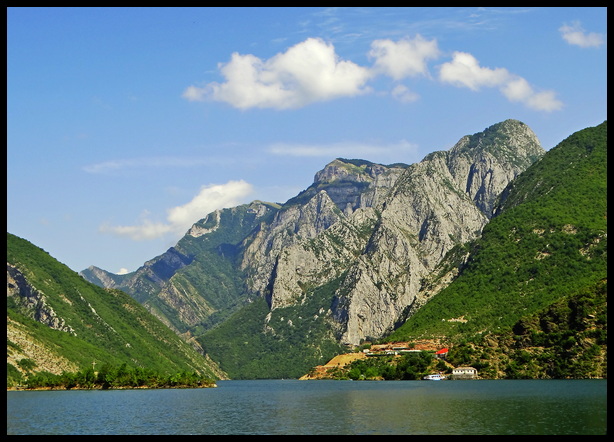
Lake Koman – northern Albania
Introduction to Albania
The Republic of Albania is a small mountainous country situated along the Adriatic Sea on the Balkan Peninsula. It’s been an independent country since 1912, when it gained its independence from the Ottoman Turk Empire.
The official religion is Islam, due to the Turkish reign, but the government and people honor religious diversity. It’s a really lax, easy-going Islamic culture. Along with mosques, Catholic & Eastern Orthodox churches have been established all over the region for centuries and people of different faiths seem to get along well in Albania.
I’ve been traveling around Albania just 10 short days, thus far, having entered from Montenegro’s southern border near Lake Shkoder.
In that time I’ve cycled the shores of massive Lake Shkoder, visited Razafa Castle ruins and Shkoder city, taken the stunning Lake Komani Ferry trip through rugged mountains (claimed as one of the most spectacular ferry rides in the world!)…
I’ve hiked in the magnificent Valbona Valley, taken a bus through Kosovo (neighboring country) to reach the Albanian capital city of Tirana, and admired the pretty historic district in downtown Tirana.
I’ve eaten delicious (and cheap!) meals, breads, pastries, fruits & vegetables. I’ve met many warm, helpful Albanians and even had the – very surprising – luck of being served Italian dark roast esspresso in cafes here!
Needless to say, I’ve been greatly enjoying my travels around Albania. Before I leave the country I’ll be writing more about what to see & do here as well as the costs of budget travel around Albania.
For the moment, here’s my introduction to Albania, based on research and talks with locals.
 Location and Geography of Albania
Location and Geography of Albania
The Balkan Peninsula is located just east of Italy. The long narrow Adriatic Sea separates Italy’s long boot-shaped mainland from the Balkan coast. Directly across the sea from southeastern Italy is Albania, sandwich-ed between Greece (to its south) and Montenegro to the north.
As you can see from the map, Albania has a relatively long coastline on the Adriatic Sea, with plenty of beaches and rocky, mountainous shoreline.
Most of the country is very mountainous, with the highest, most-rugged peaks located in the north at the borders of Montenegro and Kosovo. Also sharing the border with Montenegro is huge Lake Shkoder, the largest lake in the Balkans and one of the most important bird reserves in all of Europe.
There’s also a broad flat strip of land along some of the coast and the large central area around the capital city, Tirana.
Albania has abundant water, including the long Adriatic Coast, many rivers and several lakes of varying sizes, both natural and artificially-created dammed river lakes. The Albanian government has taken great advantage of hydro-electric power, to its credit.
Albania is bordered on the interior by Greece, Macedonia, Kosovo and Montenegro.
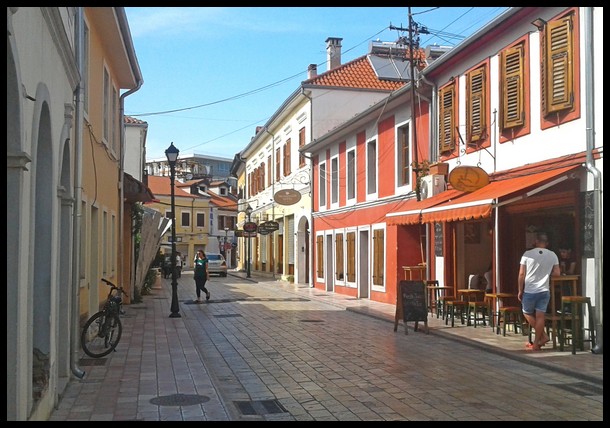 Recent History of Albania
Recent History of Albania
Albania has a very different modern-day history from its neighboring Balkan countries. First off, Albania was never part of the communist state of Yugoslavia that was created out of WWII.
In fact, Albania has been an independent country for much longer that either Yugoslavia or any of the small countries that were formed when Yugoslavia collapsed in 1991.
As I noted above, the Republic of Albania was established in 1912, when it gained its independence from the Ottoman Turkish Empire that had control of the region for 400-500 years (sources disagree on how long). The centuries-long Turkish control and influence also make the region somewhat different to other Balkan countries.
It was the Turks who brought Islam to Albania, while most surrounding countries are not Islamic. There’s a strong Turkish influence in architecture as well, with several small historic towns, such as Berat and Gjirokaster, completely filled with handsome Ottoman architecture.
From the outset in 1912, Albania was formed as a communist state, which also means it had this form of government for considerably longer than its neighboring countries, which fell under communism only with the formation of Yugoslavia in 1945. From to 1985, Albania was under the thumb of the strict, totalitarian dictator Hoxha, who ruled with complete social, political, militray & media control until his death in 1985.
In the mid 1990s Albania underwent a bloody civil war as a result of the currency & economy collapsing from investment in a massive pyramid scheme. During that time hoardes of bankrupt & starving Albanians fled to Greece, Italy, Macedonia, Kosovo and even the USA and other western European countries.
In more recent years, the fighting has ceased, the economy has stabilized and Albanians living abroad have returned, bringing with them cultural elements from other western countries, especially from Italy and Greece.
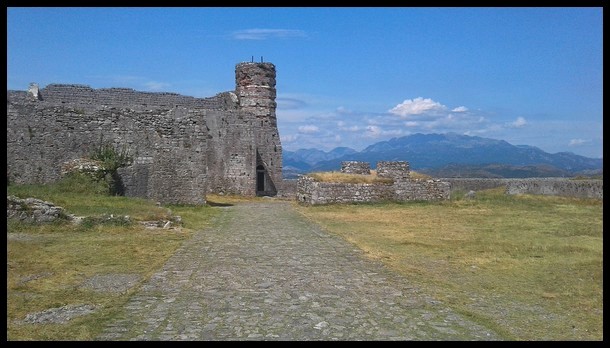 Brief Ancient History of Albania
Brief Ancient History of Albania
Like Montenegro, the area now known as Albania was inhabited by several different kingdoms and cultures over the centuries. Most prominent were the Illyrian Kingdom, the Greeks, Roman Empire, Byzantines and Ottoman Turks. As noted above, the Ottomans ruled this land for over four centuries, making significant marks on the current culture.
Looking further back, The Illyrians are considered the first major inhabitants of the area, establishing themselves in the 7th-3rd centuries B.C. (That’s 3000 years ago) This is of particular note in Albania because Albanians are widely thought to be the direct descendents of Illyrians. And Albanians consider themselves to be Illyrian descendents.
But, as I learned at the excellent National History Museum in Tirana, archeaologists have found loads of artifacts within the terrritory of Albania dating all the way back to the Neolithic Age, which goes back to 40,000 B.C. !!! They’ve also dug up plenty of artifacts from all subsequent human eras, including the New Stone Age of 7000-3050 B.C. on through the Copper, Bronze, Iron Ages and all the ancient European ages.
So it seems this region now known as Albania was part of the actual origins of humankind! Wowsers.
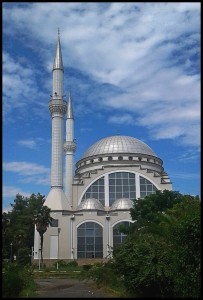 People & Culture of Albania
People & Culture of Albania
As I mentioned, Albanians are the descendents of the Illyrians, who were the first inhabitants of this Balkan region, That includes Montenegro, where the Illyrians once had their capital city in Rian, Kotor Bay in the 700-400s B.C.
In far northern Albania, in the spectacular Valbona Valley, I spoke with local families who trace their roots back over 300 years to Illyrians who migrated down from Montenegro. I was told that at one time the extensive Selimaj family owned the entire valley.
Even now, the majority of land, homes, guest houses and businesses are owned and operated by various Selimaj relatives. I even stayed at guesthouses run by two Selimaj families in Valbona Valley.
Albanians have always been a very independent & territorial people, defending themselves bravely from the various empires that invaded. They’re noted for their strong fighting abilities. They also have a very strong work ethic – meaning that they work long hours and are quite diligent at their duties.
Nowadays, Albanians apparently have strong ties to /cultural influences from Italy – just across the sea – and Greece, their southern neighbor, as a result of the many Albanian emigrants who brought bits of those cultures back with them when they returned to Albania in recent years. Italian culture is more prominent in northern Albania, while Greek influence is more prominent in the south.
I’ve seen these influences quite clearly in the cuisine. There are loads of Italian restaurants everywhere, with pasta and pizza, in particular, being extremely common & popular foods. Equally common are Greek and Turkish foods like gyros, souvlaka, mousaka, feta cheese, Greek salads, baklava and other yummy pastries.
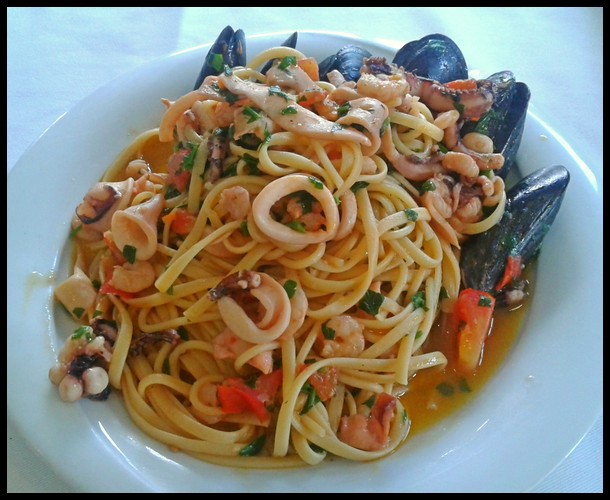 There are also loads of good bakeries, pastry/cake shops, icecream stands and fresh fruit & vegetable shops in every town & city.
There are also loads of good bakeries, pastry/cake shops, icecream stands and fresh fruit & vegetable shops in every town & city.
Cafe culture and smoking are extremely prevalent in Albania. In cities & towns, nearly every single block has at least one cafe/bar and/or restaurant. Many blocks are chock-a-block with cafes & restaurants jammed beside each other. I’m astounded at how they can all have enough clientele to stay afloat.
The cafe/bars are a bit different than what we’re used to. They serve just about every kind of drink possible, from bottled water to espresso cafes to sodas & juices to beer, wine and spirits. But they don’t serve any food, not even snacks!
It’s common for all these cafe/bars to be crowded with people of all ages sitting around chatting, drinking something or other and…invariably smoking. Recent Albanian law has made it illegal to smoke inside (meaning a space with four walls and a ceiling), so everyone now sits ‘outside’. Sometimes that’s an actual open-air patio, but often it’s a nearly-enclosed space with overhead awning and walls on nearly every side, with a bit of airflow passing through.
Albanians seem to love playing loud music (much to my chagrin!), particularly reggaeton (oh, how I LOATHE that music!) and Latino pop / rap. I hear loud music in restaurants, cafes, stores and buses. Quite unfortuantely for me, it’s generally exactly the music I hate the most.
On the other hand, many people play traditional Albanian music, which has a distinctly Arabic sound. That’s much more enjoyable for my tastes.
Cuisines of Albania
Besides strong influences fro Italy, Greece and Turkey, there are several traditional Albanian dishes, that vary from region to region. One delicious dish consists of fried green peppers in cream sauce. Local brandy, called Raki, and Cognac are traditional spirits.
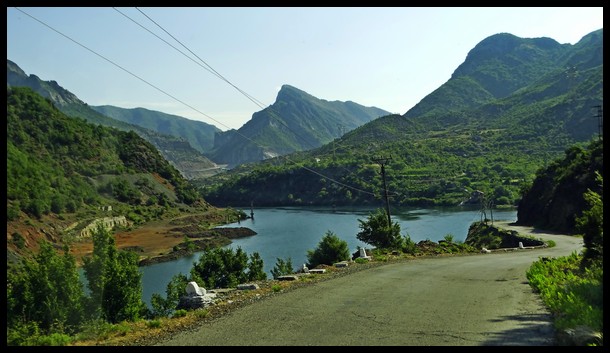
Albanian countryside
Notes on Traveling in Albania
I’ve found Albania to be an easy, pleasant and safe country to travel around. People are helpful and generally welcoming. Food is good, inexpensive and easy to find everywhere (It’s similar to SE Asia in this regard!).
Lodging is also simple to find via the internet (or just showing up and searching), for all budgets, from backpacker hostels to inexpensive private rooms to mid-range & luxury hotels.
Landscapes are gorgeous, particularly in the north and along the Adriatic coast. Albania also has some interesting small historic towns, good museums in the capital city of Tirana and quite diverse culture & architecture from different eras and cultures.
I’ve found the people quite helpful. While not many speak English, many can understand basic English and there always seems to be someone who shows up with good English to help out. Albanians in the tourist industry, museums, restaurants & cafes generally speak English.
Pubic transportation is well-established in Albania now, with buses and/or mini-vans running regularly between most destinations around the country. Roads in major areas are in great condition, while mountain roads are genrally paved but not well-maintained. Bus drivers and passengers will make sure you get to your destination.
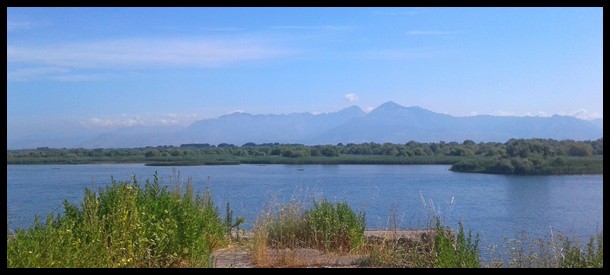
beautiful Lake Shkadar
Costs of Travel in Albania
Before arriving in Albania, I’d read and heard from other travelers that Albania is much cheaper than Montenegro. Unfortunately, I have not found htat to be the case. Overall, lodging and transportation costs are about the same as Montenegro.
To be more specific, overland buses cost about 500 lek / $4.65 for a two-hour journey or 100 lek / $9 US for a 4-5-hour trip. City buses in Tirana cost just 40 lek / $0.40 US per trip. Taxis cost more than in Montenegro, however, with a trip across the city costing about 700 lek / $6.50 US (which would cost 1-2 Euro in Montenegro cities).
Food at restaurants, however, tends to be considerably cheaper than in Montenegro. In fact, generally ½ to 1/3 the price of comparable meals in Montnegro.
Basic meals like a hefty sandwich / gyro / pita cost about 200 lek / $2.50 US. A decent meal with french fries (seemingly the only type of potato served here!) and some veggies/salad goes for 300-450 lek / $3-5 US. I ate a huge bowl of seafood pasta at a good restaurant for 450 lek / $4.50 US. For me, many of these meals are so big that I have to take half for take-away.
Beds in hostels in Albania generally cost Euro 5-8 / $6-10 US. In some places rates are higher. Individual private rooms on Booking or AirBnB don’t cost much more than that, however. I’ve found several rooms ranging from Euro 6-12 / $7-13.50 US.
Since I hate shared sleeping quarters so much, I’ve been opting for private rooms. As a result, my total costs here are about the same as in SE Asia or Central America. Looks like I’m running at about $150 US per week / $650 US per month. I’ll write a more comprehensive post on costs of budget travel soon.
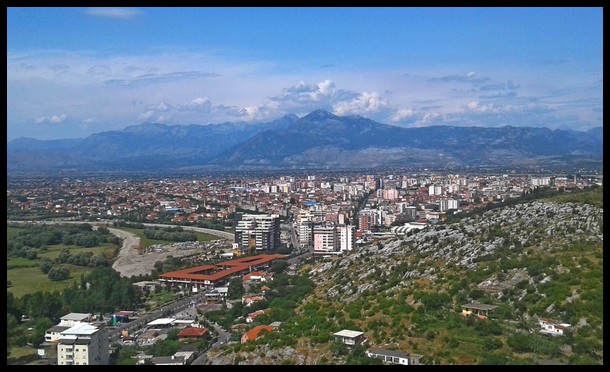
Shkoder – Albania
Summary
Albania is a great country to explore. There are beautiful lakes, spectacular mountains, developed beaches, historic towns, an interesting capital city. Costs for budget travelers are comparable to SE Asia or Central America. The country is safe, easy to negotiate with public transportation and tourist industry is in place.
==============================================



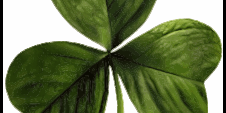


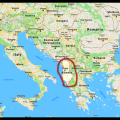
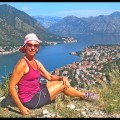
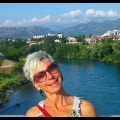
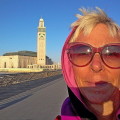

 Hi! I'm Lash, an American nomadic world traveler who's been traveling solo since 1998. I’m passionate about traveling the world nomadically and then sharing it all with you. I hope to inspire you to travel the world, to entertain you with tales from the road, and to help you reach your travel dreams. Welcome!
Hi! I'm Lash, an American nomadic world traveler who's been traveling solo since 1998. I’m passionate about traveling the world nomadically and then sharing it all with you. I hope to inspire you to travel the world, to entertain you with tales from the road, and to help you reach your travel dreams. Welcome! 




7 pings
Skip to comment form ↓
Costs of Budget Travel in Albania in 2019
2019/08/01 at 2:07 am (UTC 8) Link to this comment
[…] « Introduction to Albania […]
Introduction to Kosovo
2019/08/27 at 10:01 pm (UTC 8) Link to this comment
[…] Introduction to Albania […]
My First Impressions of Bulgaria
2020/08/27 at 7:35 pm (UTC 8) Link to this comment
[…] Introduction to Albania […]
My First Impressions of Cyprus - LashWorldTour
2020/08/27 at 7:42 pm (UTC 8) Link to this comment
[…] Introduction to Albania […]
Introduction to Krakow – Poland - LashWorldTour
2020/08/27 at 7:54 pm (UTC 8) Link to this comment
[…] Introduction to Albania […]
NEWS: Big Change in my Travel Plans 2019! - LashWorldTour
2020/08/27 at 7:55 pm (UTC 8) Link to this comment
[…] My Intro to Albania […]
ALBANIA: 30 POSTS QUE AYUDAN PARA VIAJAR [2] | Viatges pel Món
2021/02/10 at 1:58 pm (UTC 8) Link to this comment
[…] Introduction to Albania | Lash World Tour […]